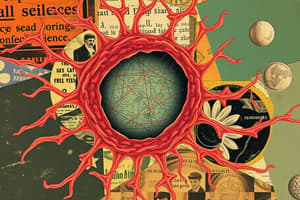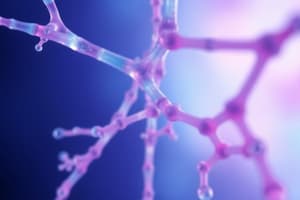Podcast
Questions and Answers
What is the function of the nucleus in a cell?
What is the function of the nucleus in a cell?
DNA and RNA synthesis; assembly of ribosomes
Who discovered cells?
Who discovered cells?
Robert Hooke
Which organelle is known as the 'janitor' of the cell?
Which organelle is known as the 'janitor' of the cell?
- Mitochondria
- Ribosomes
- Chloroplasts
- Lysosomes (correct)
What is the main function of mitochondria?
What is the main function of mitochondria?
What is apoptosis?
What is apoptosis?
What occurs during meiosis?
What occurs during meiosis?
The cell wall separates the cell from the outside.
The cell wall separates the cell from the outside.
What is the longest period of the cell cycle?
What is the longest period of the cell cycle?
Match the following genetic disorders with their descriptions:
Match the following genetic disorders with their descriptions:
Which phase in the cell cycle is known as the resting phase?
Which phase in the cell cycle is known as the resting phase?
Flashcards are hidden until you start studying
Study Notes
Cell Theory and Historical Figures
- Robert Hooke discovered cells using a microscope, coining the term "cell".
- Anton Van Leeuwenhoek observed various cells, including red blood cells and sperm.
- Robert Brown identified the nucleus within cells.
- Matthias Schleiden contributed to plant cell structures as a botanist.
- Theodore Schwann contributed to animal cell structures as a zoologist.
- Rudolf Virchow proposed that all living cells arise from pre-existing cells.
Cell Structures and Functions
- Organelles are specialized structures within cells that perform specific functions.
Manufacturing Organelles
- Nucleus: Central role in synthesizing DNA and RNA, and assembling ribosomes.
- Ribosomes: Sites of protein synthesis.
- Rough Endoplasmic Reticulum (ER): Synthesizes membrane lipids and proteins, forms transport vesicles.
- Smooth Endoplasmic Reticulum (ER): Focuses on lipid synthesis.
- Golgi Apparatus: Modifies and transports macromolecules.
Breakdown Organelles
- Lysosomes: Digestive organelles that break down ingested food.
- Vacuoles: Storage compartments for chemicals.
- Peroxisomes: Involved in various metabolic processes.
Energy Processing Organelles
- Mitochondria: Convert chemical energy from food into ATP.
- Chloroplasts: Transform light energy into chemical energy in sugars.
Structural Support and Communication
- Cytoplasm: Jelly-like substance that holds organelles in place.
- Cytoskeleton: Provides structural support, facilitates movement, and acts as a transport road.
- Centrioles: Assist in the process of cell division.
- Cell Membrane: Regulates entry and exit of substances, separates the cell from its environment.
- Cell Wall: Provides support and protection to the cell.
Cell Cycle
- Characterized by regular, repetitive physical and metabolic activities.
- Comprises two main periods: Interphase and M-phase (mitosis/meiosis).
Interphase
- G1 Phase: Cell volume increases.
- S Phase: DNA and histones synthesis occur.
- G2 Phase: RNA and essential proteins for chromosome formation are synthesized.
M-phase
- Involves the actual division of the cell.
Cell Cycle Checkpoints
- G1 checkpoint: Assesses nutrients, DNA integrity, and growth factors.
- Metaphase checkpoint: Checks for proper chromosome spindle attachment.
- G2 checkpoint: Evaluates cell size and completion of DNA replication.
Mitosis and Meiosis
- Mitosis: Somatic cell division for producing two daughter nuclei from replicated chromosomes.
Stages of Mitosis
- Prophase: Chromosomes condense, becoming visible.
- Metaphase: Spindle fibers attach to centromeres.
- Anaphase: Sister chromatids separate as centromeres split.
- Telophase: Daughter chromatids reach poles and begin to de-condense.
Meiosis
- Involves two rounds of nuclear division following one DNA replication cycle, resulting in four gametes.
- Meiosis occurs exclusively in reproductive organs (gonads).
Stages of Meiosis I
- Prophase I: Chromosomes condense and homologous chromosomes pair to form tetrads.
- Metaphase I: Homologous chromosome pairs align at the cell's equator.
- Anaphase I: Homologous chromosomes are pulled to opposite poles.
Stages of Meiosis II
- Telophase I and Cytokinesis: Chromosomes arrive at poles, and the cytoplasm divides.
- Prophase II: New spindle apparatus forms around chromosomes.
- Metaphase II: Chromosomes align at the equator once more.
- Anaphase II: Centromeres divide, separating sister chromatids.
- Telophase II and Cytokinesis: Nuclear envelopes form around each new set of chromosomes.
Gametogenesis and Importance of Meiosis
- Gametogenesis refers to the production of sex cells (gametes).
- Key processes in meiosis include independent assortment, crossing over, and fertilization, all crucial for genetic diversity.
Genetic Disorders
- Turner Syndrome (45, X): Affects females with a missing X chromosome.
- Trisomy 21 (Down Syndrome): Characterized by the presence of an extra chromosome 21, linked to genetic factors.
- Klinefelter Syndrome (47, XXY): Affects males, commonly involving reproductive issues.
- Trisomy X (47, XXX): Typically associated with learning disabilities.
Cell Modifications
- Cilia: Hair-like structures aiding in locomotion and removing contaminants.
- Flagella: Long, whip-like structures enabling movement in bacteria, fungi, and sperm cells.
- Pseudopodia: Extensions of the cell used for locomotion and engulfing food.
Studying That Suits You
Use AI to generate personalized quizzes and flashcards to suit your learning preferences.




